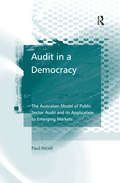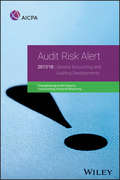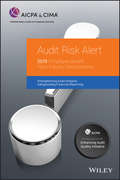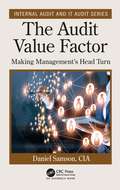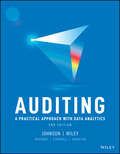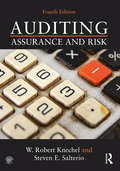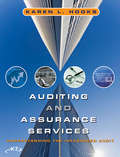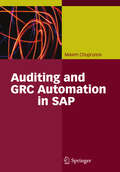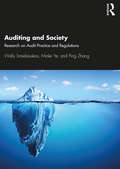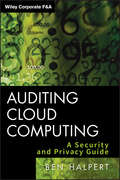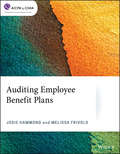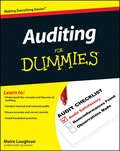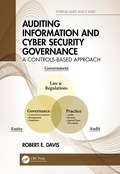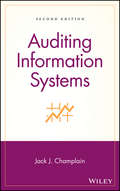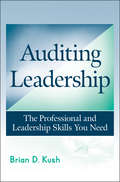- Table View
- List View
Audit in a Democracy: The Australian Model of Public Sector Audit and its Application to Emerging Markets
by Paul NicollExploring the role of public sector audit in emerging democracies and developing countries, this book provides an account of the relationship between the public sector auditor, the legislature and executive government. In particular, it introduces public sector audit's capacity to assess government agencies' compliance with the law and their management of taxpayer or internationally funded programs and services. The volume: ¢ Explores the Australian model of public sector audit. ¢ Provides a definition of a supreme Audit Institution (SAI) and the role and responsibilities of the public sector auditor. ¢ Examines the authority necessary for the SAI to function effectively. ¢ Discusses likely future reform of the SAI's legal framework. ¢ Illustrates how audit can be used to strengthen democratic institutions in emerging market economies. It will be of use to researchers, academics and students interested in the critical issues surrounding audit in general and public sector audit in particular. It will also be a valuable guide to practitioners in this area.
Audit Risk Alert: General Accounting and Auditing Developments, 2017/18 (AICPA)
by AICPAUpdated annually, this useful resource contains a description of all recent auditing, accounting and regulatory developments to ensure that the accountant has a robust understanding of the business, economic, and regulatory environments in which they and their clients operate. In addition, this alert ensures that the accountant has a full understanding of emerging practice issues, with targeted analysis of new developments and how they may affect your engagements, including: • Recent Economic Trends • Recent Legislative and PCAOB Developments • Developments in Peer Review • Recent Ethics Interpretations It also contains new accounting and auditing guidance related to derivatives and hedging, service concession agreements, discontinued operations, stock compensation, and more
Audit Risk Alert: Employee Benefit Plans Industry Developments, 2019 (AICPA)
by AICPAThe increasing complexity of employee benefit plan auditing and focus by the Department of Labor have resulted in significant pressure for CPAs and firms performing EBP audits. To help CPAs meet the challenge of performing quality audits in this unique and complex area, the AICPA has developed this alert to assist in identifying current sources of risk within EBP audit engagements. Written by a task force consisting of current and former employee benefit plan expert panel members, this alert features discussions on new developments and issues that auditors may face in their current audits, as well as a look at what's in the pipeline that may affect your engagements. Updates in 2019: FASB ASU No. 2017-06, Employee Benefit Plan Master Trust Reporting FASB ASU No. 2018-09, Codification Improvements FASB ASU No. 2018-13, Fair Value Measurement (Topic 820), Disclosure Framework–Changes to the Disclosure Requirements for Fair Value Measurement
Audit Risk Alert: Employee Benefit Plans Industry Developments, 2019 (AICPA)
by AICPAThe increasing complexity of employee benefit plan auditing and focus by the Department of Labor have resulted in significant pressure for CPAs and firms performing EBP audits. To help CPAs meet the challenge of performing quality audits in this unique and complex area, the AICPA has developed this alert to assist in identifying current sources of risk within EBP audit engagements. Written by a task force consisting of current and former employee benefit plan expert panel members, this alert features discussions on new developments and issues that auditors may face in their current audits, as well as a look at what's in the pipeline that may affect your engagements. Updates in 2019: FASB ASU No. 2017-06, Employee Benefit Plan Master Trust Reporting FASB ASU No. 2018-09, Codification Improvements FASB ASU No. 2018-13, Fair Value Measurement (Topic 820), Disclosure Framework–Changes to the Disclosure Requirements for Fair Value Measurement
Audit Risk Alert: General Accounting and Auditing Developments, 2017/18 (AICPA)
by AICPAUpdated annually, this useful resource contains a description of all recent auditing, accounting and regulatory developments to ensure that the accountant has a robust understanding of the business, economic, and regulatory environments in which they and their clients operate. In addition, this alert ensures that the accountant has a full understanding of emerging practice issues, with targeted analysis of new developments and how they may affect your engagements, including: • Recent Economic Trends • Recent Legislative and PCAOB Developments • Developments in Peer Review • Recent Ethics Interpretations It also contains new accounting and auditing guidance related to derivatives and hedging, service concession agreements, discontinued operations, stock compensation, and more
The Audit Value Factor (Internal Audit and IT Audit)
by Daniel SamsonThe Audit Value Factor: Making Management’s Head Turn empowers readers with a systematic method to build and maintain a value-centric internal audit organization. The book explores how to identify, quantify, and articulate value for customers. It details six critical success factors: Value propositions that link directly to customer needs Fostering customer relationships using the CREATE model Talent development using the TEAM model Risk expertise that raises awareness, understanding, and action Change management and process optimization using the SMART model Data analytics that provide powerful insights to operations The Audit Value Factor offers easy to use tools and practical strategies that deliver tangible and immediate benefits for the internal audit team. Praise for The Audit Value Factor: Making Management’s Head Turn "Daniel Samson, the inspiring and forward-thinking CAE at SRI International, has created an essential guide to adding value through Internal Audit in his new book The Audit Value Factor. It's an important addition to any internal auditor's toolkit, with helpful suggestions on topics ranging from talent planning to data analytics. I highly recommend it to any internal audit professional looking to "up their game." Laurie A. Hanover, CIA, CAE Sunrun Inc. "Internal Auditors often strive for a ‘seat at the table,’ be it with Business Leaders, Senior Management, the Board, or really, any significant decision maker in an organization. In The Audit Value Factor, Dan Samson provides the roadmap to ensuring that Internal Audit gets not only that seat at the table, but also that role of a critical business partner that is valued in facilitating change and helping an organization achieve its goals." Brian Tremblay, CAE Acacia Communications "Great audit functions generate value and build leadership capacity from staff to CAE. The Audit Value Factor’s compelling examples, data, and actionable tools enable auditors at every level to build relationships of trust, ask the right questions, and deliver powerful insights to their organization." Dr. Kathryn Bingham, Executive Coach and CEO, LEADistics LLC
The Audit Value Factor (Internal Audit and IT Audit)
by Daniel SamsonThe Audit Value Factor: Making Management’s Head Turn empowers readers with a systematic method to build and maintain a value-centric internal audit organization. The book explores how to identify, quantify, and articulate value for customers. It details six critical success factors: Value propositions that link directly to customer needs Fostering customer relationships using the CREATE model Talent development using the TEAM model Risk expertise that raises awareness, understanding, and action Change management and process optimization using the SMART model Data analytics that provide powerful insights to operations The Audit Value Factor offers easy to use tools and practical strategies that deliver tangible and immediate benefits for the internal audit team. Praise for The Audit Value Factor: Making Management’s Head Turn "Daniel Samson, the inspiring and forward-thinking CAE at SRI International, has created an essential guide to adding value through Internal Audit in his new book The Audit Value Factor. It's an important addition to any internal auditor's toolkit, with helpful suggestions on topics ranging from talent planning to data analytics. I highly recommend it to any internal audit professional looking to "up their game." Laurie A. Hanover, CIA, CAE Sunrun Inc. "Internal Auditors often strive for a ‘seat at the table,’ be it with Business Leaders, Senior Management, the Board, or really, any significant decision maker in an organization. In The Audit Value Factor, Dan Samson provides the roadmap to ensuring that Internal Audit gets not only that seat at the table, but also that role of a critical business partner that is valued in facilitating change and helping an organization achieve its goals." Brian Tremblay, CAE Acacia Communications "Great audit functions generate value and build leadership capacity from staff to CAE. The Audit Value Factor’s compelling examples, data, and actionable tools enable auditors at every level to build relationships of trust, ask the right questions, and deliver powerful insights to their organization." Dr. Kathryn Bingham, Executive Coach and CEO, LEADistics LLC
Auditing: Assurance and Risk
by W. Robert Knechel Steven E. SalterioFocusing on auditing as a judgment process, this unique textbook helps readers strike the balance between understanding auditing theory and how an audit plays out in reality. The only textbook to provide complete coverage of both the International Auditing and Assurance Standards Board and the Public Company Accounting Oversight Board, Auditing reflects the contemporary evolution of the audit process. New additions to the book include expert updates on key topics, such as the audit of accounting estimates, group audit, and the Integrated Audit. Supplemented by extra on-line resources, students using this established text will be well-equipped to be effective auditors and to understand the role of auditing in the business world.
Auditing: Assurance and Risk (Routledge Companions In Business, Management And Accounting Ser.)
by W. Robert Knechel Steven E. SalterioFocusing on auditing as a judgment process, this unique textbook helps readers strike the balance between understanding auditing theory and how an audit plays out in reality. The only textbook to provide complete coverage of both the International Auditing and Assurance Standards Board and the Public Company Accounting Oversight Board, Auditing reflects the contemporary evolution of the audit process. New additions to the book include expert updates on key topics, such as the audit of accounting estimates, group audit, and the Integrated Audit. Supplemented by extra on-line resources, students using this established text will be well-equipped to be effective auditors and to understand the role of auditing in the business world.
Auditing and Assurance Services: Understanding the Integrated Audit
by Karen L. HooksPrinciples of Auditing presents auditing from the perspective of an integrated audit complying the Sarbanes Oxley Act (SOX), under the standards of the Public Companies Accounting Oversight Board. It is the first textbook completely authored after SOX, and consequently uses the integrated audit model throughout. In addition, this text also facilitates an understanding of audits of non-public companies. A primary focus is the need for auditors to understand their clients and their industries. Highlighted illustrative industries include: health care providers, retail enterprises, the automotive industry, and the land development and home building industry.
Auditing and GRC Automation in SAP
by Maxim ChuprunovOver the last few years, financial statement scandals, cases of fraud and corruption, data protection violations, and other legal violations have led to numerous liability cases, damages claims, and losses of reputation. As a reaction to these developments, several regulations have been issued: Corporate Governance, the Sarbanes-Oxley Act, IFRS, Basel II and III, Solvency II and BilMoG, to name just a few. In this book, compliance is understood as the process, mapped not only in an internal control system, that is intended to guarantee conformity with legal requirements but also with internal policies and enterprise objectives (in particular, efficiency and profitability).The current literature primarily confines itself to mapping controls in SAP ERP and auditing SAP systems. Maxim Chuprunov not only addresses this subject but extends the aim of internal controls from legal compliance to include efficiency and profitability and then well beyond, because a basic understanding of the processes involved in IT-supported compliance management processes are not delivered along with the software. Starting with the requirements for compliance (Part I), he not only answers compliance-relevant questions in the form of an audit guide for an SAP ERP system and in the form of risks and control descriptions (Part II), but also shows how to automate the compliance management process based on SAP GRC (Part III). He thus addresses the current need for solutions for implementing an integrated GRC system in an organization, especially focusing on the continuous control monitoring topics. Maxim Chuprunov mainly targets compliance experts, auditors, SAP project managers and consultants responsible for GRC products as readers for his book. They will find indispensable information for their daily work from the first to the last page. In addition, MBA, management information system students as well as senior managers like CIOs and CFOs will find a wealth of valuable information on compliance in the SAP ERP environment, on GRC in general and its implementation in particular.
Auditing and Society: Research on Audit Practice and Regulations
by Wally Smieliauskas Minlei Ye Ping ZhangAuditing has become an essential component in market societies and the need for auditing skills has risen in line with globalization. This textbook provides a comprehensive overview of the role of financial statement auditing in contemporary society, including the auditor’s role in evaluating the financial reporting of an auditee—a topic of central concern in the recent comprehensive review of the auditing profession in the Brydon Report (2019). The experienced authors provide insight into auditing research to help readers understand its function, regulation, and role in theory and practice. With focus on private sector financial statement auditing and its regulation, the book includes perspectives on social theory, history, and the importance of professional standards. The thought-provoking final chapter challenges students to consider the effectiveness of auditing in evaluating increasingly risky and complex accounting estimates involving assumptions about future events. A fundamental approach to auditing theory, this textbook will be useful reading for advanced undergraduate and postgraduate students across business and accounting fields.
Auditing and Society: Research on Audit Practice and Regulations
by Wally Smieliauskas Minlei Ye Ping ZhangAuditing has become an essential component in market societies and the need for auditing skills has risen in line with globalization. This textbook provides a comprehensive overview of the role of financial statement auditing in contemporary society, including the auditor’s role in evaluating the financial reporting of an auditee—a topic of central concern in the recent comprehensive review of the auditing profession in the Brydon Report (2019). The experienced authors provide insight into auditing research to help readers understand its function, regulation, and role in theory and practice. With focus on private sector financial statement auditing and its regulation, the book includes perspectives on social theory, history, and the importance of professional standards. The thought-provoking final chapter challenges students to consider the effectiveness of auditing in evaluating increasingly risky and complex accounting estimates involving assumptions about future events. A fundamental approach to auditing theory, this textbook will be useful reading for advanced undergraduate and postgraduate students across business and accounting fields.
Auditing Cloud Computing: A Security and Privacy Guide (Wiley Corporate F&A #21)
by Ben HalpertThe auditor's guide to ensuring correct security and privacy practices in a cloud computing environment Many organizations are reporting or projecting a significant cost savings through the use of cloud computing—utilizing shared computing resources to provide ubiquitous access for organizations and end users. Just as many organizations, however, are expressing concern with security and privacy issues for their organization's data in the "cloud." Auditing Cloud Computing provides necessary guidance to build a proper audit to ensure operational integrity and customer data protection, among other aspects, are addressed for cloud based resources. Provides necessary guidance to ensure auditors address security and privacy aspects that through a proper audit can provide a specified level of assurance for an organization's resources Reveals effective methods for evaluating the security and privacy practices of cloud services A cloud computing reference for auditors and IT security professionals, as well as those preparing for certification credentials, such as Certified Information Systems Auditor (CISA) Timely and practical, Auditing Cloud Computing expertly provides information to assist in preparing for an audit addressing cloud computing security and privacy for both businesses and cloud based service providers.
Auditing Cloud Computing: A Security and Privacy Guide (Wiley Corporate F&A #21)
by Ben HalpertThe auditor's guide to ensuring correct security and privacy practices in a cloud computing environment Many organizations are reporting or projecting a significant cost savings through the use of cloud computing—utilizing shared computing resources to provide ubiquitous access for organizations and end users. Just as many organizations, however, are expressing concern with security and privacy issues for their organization's data in the "cloud." Auditing Cloud Computing provides necessary guidance to build a proper audit to ensure operational integrity and customer data protection, among other aspects, are addressed for cloud based resources. Provides necessary guidance to ensure auditors address security and privacy aspects that through a proper audit can provide a specified level of assurance for an organization's resources Reveals effective methods for evaluating the security and privacy practices of cloud services A cloud computing reference for auditors and IT security professionals, as well as those preparing for certification credentials, such as Certified Information Systems Auditor (CISA) Timely and practical, Auditing Cloud Computing expertly provides information to assist in preparing for an audit addressing cloud computing security and privacy for both businesses and cloud based service providers.
Auditing Employee Benefit Plans (AICPA)
by Josie Hammond Melissa FrivoldMaster the fundamentals of auditing employee benefit plans in accordance with AICPA standards and ERISA rules and regulations. Written by a member on the expert panel for employee benefit plans, this book is designed to give an understanding of the requirements and audit procedures related to defined contribution, defined benefit, and health and welfare plans to help accountants more effectively plan and carry out their audit. Topics include: FASB ASU 2017-06, which significantly impacted master trust accounting, reporting and disclosures for employee benefit plans PCAOB adopted AS 3101 in 2017 which resulted in significant changes to the existing auditor's report. New insert for SAS No. 136, Forming an Opinion and Reporting on Financial Statements of Employee Benefit Plans Subject to ERISA
Auditing Employee Benefit Plans (AICPA)
by Josie Hammond Melissa FrivoldMaster the fundamentals of auditing employee benefit plans in accordance with AICPA standards and ERISA rules and regulations. Written by a member on the expert panel for employee benefit plans, this book is designed to give an understanding of the requirements and audit procedures related to defined contribution, defined benefit, and health and welfare plans to help accountants more effectively plan and carry out their audit. Topics include: FASB ASU 2017-06, which significantly impacted master trust accounting, reporting and disclosures for employee benefit plans PCAOB adopted AS 3101 in 2017 which resulted in significant changes to the existing auditor's report. New insert for SAS No. 136, Forming an Opinion and Reporting on Financial Statements of Employee Benefit Plans Subject to ERISA
Auditing For Dummies
by Maire LoughranThe easy way to master the art of auditing Want to be an auditor and need to hone your investigating skills? Look no further. This friendly guide gives you an easy-to-understand explanation of auditing — from gathering financial statements and accounting information to analyzing a client's financial position. Packed with examples, it gives you everything you need to ace an auditing course and begin a career today. Auditing 101 — get a crash course in the world of auditing and a description of the types of tasks you'll be expected to perform during a typical day on the job It's risky business — find out about audit risk and arm yourself with the know-how to collect the right type of evidence to support your decisions Auditing in the real world — dig into tons of sample business records to perform your first audit Focus on finances — learn how both ends of the financial equation — balance sheet and income statement — need to be presented on your client's financial statements Seal the deal — get the lowdown on how to wrap up your audit and write your opinion After the audit — see the types of additional services that may be asked of you after you've issued your professional opinion
Auditing For Dummies
by Maire LoughranThe easy way to master the art of auditing Want to be an auditor and need to hone your investigating skills? Look no further. This friendly guide gives you an easy-to-understand explanation of auditing — from gathering financial statements and accounting information to analyzing a client's financial position. Packed with examples, it gives you everything you need to ace an auditing course and begin a career today. Auditing 101 — get a crash course in the world of auditing and a description of the types of tasks you'll be expected to perform during a typical day on the job It's risky business — find out about audit risk and arm yourself with the know-how to collect the right type of evidence to support your decisions Auditing in the real world — dig into tons of sample business records to perform your first audit Focus on finances — learn how both ends of the financial equation — balance sheet and income statement — need to be presented on your client's financial statements Seal the deal — get the lowdown on how to wrap up your audit and write your opinion After the audit — see the types of additional services that may be asked of you after you've issued your professional opinion
Auditing Information and Cyber Security Governance: A Controls-Based Approach (Internal Audit and IT Audit)
by Robert E. DavisA comprehensive entity security program deploys information asset protection through stratified technological and non-technological controls. Controls are necessary for counteracting threats, opportunities, and vulnerabilities risks in a manner that reduces potential adverse effects to defined, acceptable levels. This book presents a methodological approach in the context of normative decision theory constructs and concepts with appropriate reference to standards and the respective guidelines. Normative decision theory attempts to establish a rational framework for choosing between alternative courses of action when the outcomes resulting from the selection are uncertain. Through the methodological application, decision theory techniques can provide objectives determination, interaction assessments, performance estimates, and organizational analysis. A normative model prescribes what should exist according to an assumption or rule.
Auditing Information and Cyber Security Governance: A Controls-Based Approach (Internal Audit and IT Audit)
by Robert E. DavisA comprehensive entity security program deploys information asset protection through stratified technological and non-technological controls. Controls are necessary for counteracting threats, opportunities, and vulnerabilities risks in a manner that reduces potential adverse effects to defined, acceptable levels. This book presents a methodological approach in the context of normative decision theory constructs and concepts with appropriate reference to standards and the respective guidelines. Normative decision theory attempts to establish a rational framework for choosing between alternative courses of action when the outcomes resulting from the selection are uncertain. Through the methodological application, decision theory techniques can provide objectives determination, interaction assessments, performance estimates, and organizational analysis. A normative model prescribes what should exist according to an assumption or rule.
Auditing Information Systems
by Jack J. ChamplainHave you been asked to perform an information systems audit and don't know where to start? Examine a company's hardware, software, and data organization and processing methods to ensure quality control and security with this easy, practical guide to auditing computer systems--the tools necessary to implement an effective IS audit. In nontechnical language and following the format of an IS audit program, you'll gain insight into new types of security certifications (e.g., TruSecure, CAP SysTrust, CPA WebTrust) as well as the importance of physical security controls, adequate insurance, and digital surveillance systems. Order your copy today!
Auditing Leadership: The Professional and Leadership Skills You Need
by Brian D. KushHow can you start a culture of feedback that improves your organization? Turn to page 27. Want to know the most important word to an auditor? Turn to page 65. Do you train people to interrupt you? Want to stop? Turn to page 106. What is the single biggest opportunity to improve your audit? Turn to page 172. Want to hear about the funnier side of auditing? Turn to the "You Know You Are an Auditor When…" Appendix on page 227. Praise for Auditing Leadership: The Professional and Leadership Skills You Need "From networking to e-mail, from team-building to selling yourself, Brian shows how to create a well-organized and effective working life. Although aimed at auditors, the countless ideas put forth in this book can be used by individuals in every field to grow and become more successful in their chosen careers. In fact, one particular assertion summed up the entire thesis for me: 'success is a mind-set, not a finish line.' Kush offers a multitude of unique and creative suggestions for establishing that mind-set." —Joe Hoyle, Associate Professor of Accounting, University of Richmond, and cofounder, www.CPAreviewforFREE.com "Auditing Leadership is a must-read for new graduates and a solid resource for seasoned professionals. Brian Kush has taken a wide range of best practice advice and distilled it into a fantastic handbook for the auditing profession." —Andrew Prather, CPA, Shareholder Clark Nuber PS "Brian's book takes you beyond the technical skills of auditing to help you become both a professional and a leader. The scope of topics covered is impressive, from e-mail communications to accountability to planning your future. The book includes sound, actionable advice that will benefit auditors at all stages of their careers, from staff to partner." —Louise M. Peabody, CPA, Member Watkins Meegan, LLC
Auditing Leadership: The Professional and Leadership Skills You Need
by Brian D. KushHow can you start a culture of feedback that improves your organization? Turn to page 27. Want to know the most important word to an auditor? Turn to page 65. Do you train people to interrupt you? Want to stop? Turn to page 106. What is the single biggest opportunity to improve your audit? Turn to page 172. Want to hear about the funnier side of auditing? Turn to the "You Know You Are an Auditor When…" Appendix on page 227. Praise for Auditing Leadership: The Professional and Leadership Skills You Need "From networking to e-mail, from team-building to selling yourself, Brian shows how to create a well-organized and effective working life. Although aimed at auditors, the countless ideas put forth in this book can be used by individuals in every field to grow and become more successful in their chosen careers. In fact, one particular assertion summed up the entire thesis for me: 'success is a mind-set, not a finish line.' Kush offers a multitude of unique and creative suggestions for establishing that mind-set." —Joe Hoyle, Associate Professor of Accounting, University of Richmond, and cofounder, www.CPAreviewforFREE.com "Auditing Leadership is a must-read for new graduates and a solid resource for seasoned professionals. Brian Kush has taken a wide range of best practice advice and distilled it into a fantastic handbook for the auditing profession." —Andrew Prather, CPA, Shareholder Clark Nuber PS "Brian's book takes you beyond the technical skills of auditing to help you become both a professional and a leader. The scope of topics covered is impressive, from e-mail communications to accountability to planning your future. The book includes sound, actionable advice that will benefit auditors at all stages of their careers, from staff to partner." —Louise M. Peabody, CPA, Member Watkins Meegan, LLC
